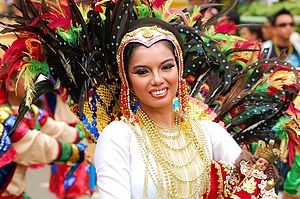The Visayans or Visayan people (Visayan languages: Bisaya) are a Filipino ethnic group whose members share a great extent of cultural, historical and linguistic affinity stretching across islands within the Visayan Sea. The people are speakers of one or more Visayan languages, the most widely spoken being Cebuano, Hiligaynon, and Waray-Waray. They live in the Visayan island group and in many parts of Mindanao. Some have migrated to other parts of the Philippines, including Luzon. The Visayans, as one ethnolinguistic umbrella and notwithstanding the population exclusive to that of Visayas, are the largest ethnic group in the country, numbering at around 33 million as of 2010.Kabisay-an refers both to the Visayan people collectively and the lands occupied by them. The Anglicized term Visayas (via Hispanized plural form of Bisaya) is commonly used to refer to the latter. Based on loose definitions, the unofficial boundaries of Visayas traditionally comprise the following provinces commonly known where Visayans or people with Visayan culture reside: Aklan, Iloilo, Antique, Guimaras, Negros Occidental, Negros Oriental, Cebu, Siquijor, Bohol, Southern Leyte, Leyte, Biliran, Northern Samar, Eastern Samar, Samar, Romblon and Masbate.According to H. Otley Beyer and other anthropologists, the term Visayan was first applied only to the people of Panay and to their settlements eastward in the island of Negros, and northward in the smaller islands, which now compose the province of Romblon. In fact, at the early part of Spanish colonialization of the Philippines, the Spaniards used the term Visayan only for these areas, while the people of Cebu, Bohol, and Leyte were for a long time known only as Pintados. The name Visayan was later extended to these other islands because, as several of the early writers state, albeit erroneously, their languages are closely allied to the Visayan "dialect" of Panay. The impression of these similarities was in fact carefully analyzed by David Zorc, who, while able to linguistically classify the Austronesian subfamily termed Visayan languages, noticed their overall connections as one dialect continuum. However, these must not be confused to dialects, since not all Visayan languages contain a unified set of features.Grabiel Ribera, captain of the Spanish royal infantry in the Philippine Islands, also distinguished Panay from the rest of the Pintados Islands. In his report (dated 20 March 1579) regarding a campaign to pacify the natives living along the rivers of Mindanao (a mission he received from Dr. Francisco de Sande, Governor and Captain-General of the Archipelago), Ribera mentioned that his aim was to make the inhabitants of that island "vassals of King Don Felipe... as are all the natives of the island of Panay, the Pintados Islands, and those of the island of Luzon..."

Población total
32563654



Comentar
0